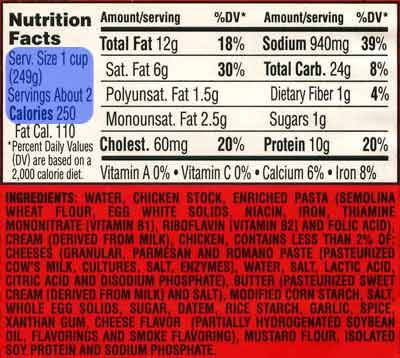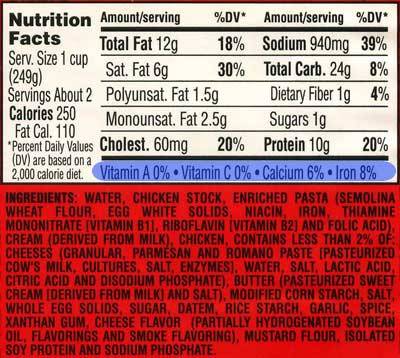
Food labels provide nutrition facts and information about the foods that your family eats.
From the amount of calories, fiber, and total fat grams, to the food’s ingredients, the food label is your key to the nutrition information in the foods you provide to your family.
It can help you to increase the healthy nutrients that you want your family to eat, like calcium and fiber, and limit nutrients that can be unhealthy, like fat, saturated fat, cholesterol, and sodium.
And reading food labels can you to compare foods that you are going to buy and choose foods that are more healthy than others.
The serving size and amount of servings per container is your real key to knowing how many calories and other nutrients are in the foods your family eats.
In general, a food with:
40 calories per serving is low in calories
100 calories per serving is moderate in calories
400 calories or more per serving is high in calories
Remember that many packages contain more than one serving and a typical serving is not necessarily the amount you can eat at one time.
For example, the nutrition label pictured above contains two servings in each container. So if you eat the whole thing by yourself, you are actually eating 500 calories (250 calories per serving X two servings), and not just 250 calories as the label makes it appear.
A common way that people overeat is by consuming oversized portions and underestimating how many calories are in the foods they eat. To help avoid this, you might choose to buy single serving packages or remove a single serving from a larger package and don’t eat out of the bag or box itself. Repackaging large bags or boxes of food into smaller, single serving packages can also be helpful.
http://pediatrics.about.com/od/nutrition/ss/food_labels_2.htm
FATS
Understanding the amount of Total Fat in the foods you eat is important so that you can provide your kids with a low fat diet.
Also keep in mind that unsaturated fats are more healthy than saturated fats and trans fats.
And remember that the American Academy of Pediatrics recommends that everyone ‘older than 2 are urged to limit their fat intake to 30 percent or less of daily calories, and to keep saturated fat to no more than one third of total fat, or 10 percent of calories.’
So reading the above food label, you should realize that this isn’t the most healthy food for your child to be eating. In addition to being very high in Sodium (which we will discuss later), about 44% of its calories are from fat (110 Fat Cal/250 Calories per serving). Plus it is high in saturated fat, which you just learned you are supposed to limit.
Bad Fats
In general, solid fats contain a lot of saturated fats and/or trans fats. These include many animal products and hydrogenated vegetable oils, including butter, beef fat, chicken fat, pork fat (lard), stick margarine, and shortening.
Most vegetable oils (except coconut oil and palm kernal oil), on the other hand, contain more monounsaturated and polyunsaturated fats.
Trans Fats
Although the amount of trans fats isn’t yet listed on most food labels, you can often identify that they are in a food if it lists ‘partially hydrogenated vegetable oil’ on the ingredient list.
In 2006, the amount of trans fats will be listed on food labels.
Carbohydrates
Unless you are on the Atkins Diet, carbohydrates should be an important source of calories in your diet.
In fact, the American Academy of Pediatrics states that ‘after infancy, children should get about half of their daily calories from carbohydrates.’
Good Carbs
The type of carbs you eat is important though. Instead of foods high in Simple Sugars, you should choose ‘starchy foods like whole grain breads and cereals, beans and rice, potatoes, and pasta.’
Example of whole grain foods include whole wheat bread, brown rice, whole wheat pasta, and whole grain cereals. These are healthier than their refined alternative – white bread, white rice, etc.
Bad Carbs
In addition to choosing foods that don’t have a lot of sugars in them, you can check the ingredient list to avoid foods with added sugars. If things like corn syrup, high-fructose corn syrup, fruit juice concentrate, maltose, dextrose, sucrose, honey, or maple syrup, are listed in the first few ingredients, then the food does have added sugars and you might look for a alternative with less sugar.
http://pediatrics.about.com/od/nutrition/ss/food_labels_4.htm
Dietary Fiber

Fiber is an important part of a healthy diet and most experts recommend that both children and adults eat a high fiber diet.
According to the American Academy of Pediatrics, ‘people who eat a lot of fiber are less likely to be obese, have heart disease, or develop problems affecting the bowel, including constipation and cancer.’
Eating a lot of foods high in fiber is especially important to prevent and treat constipation in your children.
How much fiber do kids need? The general recommendation is that the amount of fiber that they eat each day should be equal to their age in years plus 5. So a 5 year old needs 10g of fiber each day and a 12 year old needs about 17g.
Foods that are usually high in fiber include fruits, vegetables, and whole grain cereals and breads. And reading food labels can help you to choose foods that are high in fiber. For example, the food label pictured above shows just 1g of dietary fiber, while a food high in fiber, like a can of vegetable soup, might have 4 or 5g of fiber per serving.
Vitamins and Minerals
Reading food labels can also help you find foods that are high in certain vitamins and minerals that your kids need, like calcium and iron.
Remember that 5% DV or less is low and 20% DV or more is high for a food component. Foods that are a good source for a particular vitamin contain between 10 to 19% DV of that nutrient in each serving. So this example is not a good source for any of the vitamins or minerals listed on the food label.
Keep in mind that calcium rich foods contain about 20 to 30 percent of a child’s percent daily value per serving. If your child doesn’t drink a lot of milk or other dairy products that are high in calcium, be sure to check the food labels and find foods high in calcium to make sure that your child gets enough.
Also be aware that teens need more than the 100% DV listed on food labels. They actually need 130% DV of calcium and that makes choosing high calcium foods even more important.
By checking the Calcium % in foods, you will see that certain products, like orange juice, can have any where between 5 and 30% calcium, so check those food labels.
Cholesterol Sodium Protein
Like fat, you should limit the amount of cholesterol and sodium in your child’s diet.
If you consider that 5% DV or less is low and 20% DV or more is high, you can see that the food label pictured above is high in both cholesterol and sodium.
A good way to find foods that are low in sodium is to read labels and choose those foods that have less than 140 mg of sodium per serving or that are labeled as being ‘low in sodium’ or ‘very low in sodium.’
To find foods that are low in cholesterol, look for foods with less than 20 mg of cholesterol per serving.
Many of today’s popular diets, such as Atkins and the South Beach Diet, put an emphasis on eating a lot of protein and avoiding carbs. However, according to the American Academy of Pediatrics, protein should only ‘make up about 10 to 12 percent of each day’s calories.’ And keep in mind that most children in America get more protein than they need in their diet, especially if they eat meat, eggs, milk products, and a variety of plant based foods, such as beans, nuts, and soy products.
Percent Daily Value
Understanding the Percent Daily Values on a food label can help you choose foods that are high in good nutrients and low in bad nutrients.
Remember that 5% DV or less is low and 20% DV or more is high for a food component. So for things like fat, saturated fat, trans fat, cholesterol, or sodium, look for foods with a low % DV. For these nutrients, you should try to eat less than the 100% DV.
And look for a high % DV for ‘good things,’ like dietary fiber, vitamin A, vitamin C, calcium, and iron. You should be eating at least the 100% DV for these nutrients.
One thing to consider is that the % DV is based on a 2,000 calorie diet, which is the average energy needs for a child that is 7-10 years old. So for your older children and teens, they will likely need more than 100% DV.
Also remember that the Percent Daily Values are listed for a single serving, so if you eat two servings, you should double %DV. For this food label, you can see that eating two servings provides your kids with almost 80% of their Percent Daily Value of sodium!
Reviewing the ingredients list is important, especially if your kids have food allergies. Reading the food label pictured above, you can see that this food has cow’s milk, wheat flour, and eggs, so wouldn’t be a good idea for a child with a milk, wheat and/or egg allergy.
The ingredient list can also help you identify ‘hidden’ ingredients, like added sugars (bad), whole grains (good), and trans fats (bad).
Added Sugars
Foods with added sugars will list corn syrup, fruit juice concentrates, honey, molasses, etc. on their ingredient list. Other names for added sugars can include:
brown sugar
corn sweetener
dextrose
fructose
glucose
high-fructose corn syrup
invert sugar
lactose
maltose
malt syrup
raw sugar
sucrose
sugar
syrup
Whole Grains
The ingredient list can also help you find foods made with whole grains, which are healthier and are preferred to refined grains. Whole grain foods should have one of the following whole grain ingredients listed as their first ingredient:
whole wheat
whole oats
brown rice
bulgar
graham flour
oatmeal
whole grain corn
whole rye
wild rice
On the other hand, a food is not made with whole grains if it is labeled with the words multi-grain, 100% wheat, seven-grain, stone-ground, bran, or cracked wheat.
Trans Fats
Although the amount of trans fats isn’t yet listed on most food labels, making them hard to avoid, you can often identify that they are in a food if it lists ‘partially hydrogenated vegetable oil’ on the ingredient list.
http://pediatrics.about.com/od/nutrition/ss/food_labels_9.htm






